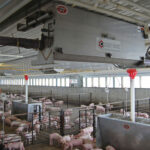Under Cover
In exchange for a little TLC, Rich Bennett’s fields produce healthy yields of grain, while saving him fertilizer, herbicide, fuel and time. Rich Bennett has gone old school. Like generations before him, he uses cover crops. As a result, he...
Under Cover
In exchange for a little TLC, Rich Bennett’s fields produce healthy yields of grain, while saving him fertilizer, herbicide, fuel and time. Rich Bennett has gone old school. Like generations before him, he uses cover crops. As a result, he...In exchange for a little TLC, Rich Bennett’s fields produce healthy yields of grain, while saving him fertilizer, herbicide, fuel and time.
Rich Bennett has gone old school. Like generations before him, he uses cover crops. As a result, he conserves valuable soil, not to mention improve it, as well as save money on fertilizer and fuel. All the while maintaining average yields of corn, soybeans and wheat on 1,100 acres in northwestern Ohio.
“My goal is to keep something growing, to put some value-added material and organic matter back into the soil to produce the next crop,” says Rich, who operates the farm with his wife, Jeannie, and informal partner Ken Griffith. “Our yields are comparable to others in the area, and we don’t have to use the high levels of fertilizer that we once did.”
His soybeans normally yield 40 to 60 bushels per acre, and his corn is in the 165-bushel range. By using cover crops, he figures he saves 30% on the cost of fuel, fertilizer and herbicide—the rye also acts as a weed barrier. There may be a slight yield decrease from a reduction in fertilizer, but it isn’t much.
Rich also reduces tillage. “No-till soybeans into rye saves at least two passes with a disc or finishing tool, and that saves $7 per acre in fuel costs,” he says. “There’s the added benefit of soil protected from wind and heavy rains, plus rainwater infiltration through the rye root structure through the soil, leaving no standing water.”
It’s easy to tell the difference in soils that have benefited from cover crops, according to Rich. Water may stand for many days in other fields, but for only one day at the most where there are cover crops.
The Bennetts also attribute their success to using the right equipment.
They’ve used AGCO-brand and Allis equipment for decades, but made the switch to Massey Ferguson, with a MF7485. “It’s our catch-all tractor,” says Rich, who still uses his AGCO DT180.
“I had an Allis 8050 and a 7045 and wanted to update them, and I did it with the Massey 7485. It’s a good tractor to do anything from hauling grain wagons to planting soybeans. It was the first red tractor Mitchell Farm Equipment sold when they switched from orange to red.”
Everyone on the farm gives high marks to the tractor’s continuous variable transmission (CVT). Rich is totally impressed by the CVT that’s standard on his MF7485. “It’s just so smooth,” he says. “And you can go at such a slow speed. It really takes the stress out of operation. We’re really learning to take advantage of it. With a clutch, you’re always changing gears, but with CVT, you don’t have to be shifting.”
To read the whole story and for links to cover crop resources, visit http://www.myfarmlife.com/features/under-cover/.




